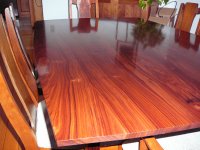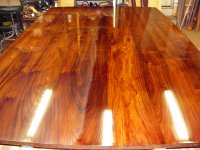I need some advice regarding sanding the topcoat of Arm-R-Seal finish. I have applied 4 coats of finish on my tabletop and there are some areas where I sanded a little heavy on my last application. I had to go a little deeper in some areas to sand out some streaking. Should I sand the entire top as deep as I sanded some areas or will a couple coats sprayed on cover up everything?
You are using an out of date browser. It may not display this or other websites correctly.
You should upgrade or use an alternative browser.
You should upgrade or use an alternative browser.
Question about sanding topcoat
- Thread starter bevans
- Start date
I just went to "school" using that finish on a table top this past winter. The first thing to remember is that once you sand through a layer, the next layer doesn't burn in or heal that sand through. The reason you see swirls after a lot of coats is that the next layer only bonds to the one below it so the islands of sand through are still there.
I spent a month (with drying time being the biggest time burner) trying to get a uniform finish but, ultimately I had to go back to wood and start over and be ultra careful not to sand through (these layers are very thin).
Once cured the next layer doesn't dissolve the layer below it only bonds to it. When I finished putting on several layers, I didn't sand the final layer. One picture was Arm-R-Seal with the gloss finish (bottom photo) which my wife didn't like and the second was with the Semi-Gloss.
Jack
I spent a month (with drying time being the biggest time burner) trying to get a uniform finish but, ultimately I had to go back to wood and start over and be ultra careful not to sand through (these layers are very thin).
Once cured the next layer doesn't dissolve the layer below it only bonds to it. When I finished putting on several layers, I didn't sand the final layer. One picture was Arm-R-Seal with the gloss finish (bottom photo) which my wife didn't like and the second was with the Semi-Gloss.
Jack
Attachments
- Joined
- Nov 24, 2011
- Messages
- 2,004
This is one of those "gotta know the rules to break them" cases.
If it were me, I would keep stacking coats and let time heal the wounds.
There is a heirarchy amongst the senses in finishing. Tactile trumps visual. If it feels good, it IS good.
If it were me, I would keep stacking coats and let time heal the wounds.
There is a heirarchy amongst the senses in finishing. Tactile trumps visual. If it feels good, it IS good.
Scott B. said:This is one of those "gotta know the rules to break them" cases.
If it were me, I would keep stacking coats and let time heal the wounds.
There is a heirarchy amongst the senses in finishing. Tactile trumps visual. If it feels good, it IS good.
Based on my experience, if what the poster is seeing now (I assume swirls at low angles) no amount of additional coats will fix this. Trust me I went through several cans of this stuff finding that out (and calls to General Finishes although very polite didn't help). One source I found very helpful was the "Wood Whisperer" who reviewed this product and made a video on his web site explaining the different varnishes.
Again I repeat, once cured the Arm-R-Seal will not dissolve with the next coating (like oil or poly finishes).
Jack
Scott B. said:I didn't see that swirls had been mentioned. Sometimes it's a burnish issue that is visual from a depth standpoint, with no swirls.
However you describe the irregularity whether it's burnishing or what I describe as swirls ( long islands of places where it sanded through to the last layer) the point I'm trying to make is that additional coats would change this but, since you've gone this far there is nothing wrong with trying to see if you get to a place where you like what you see with additional layers.
I know I did for weeks at a time until I brought out my 150/3 and some 100 grit Garnat.
Jack
- Joined
- Nov 24, 2011
- Messages
- 2,004
jacko9 said:Scott B. said:I didn't see that swirls had been mentioned. Sometimes it's a burnish issue that is visual from a depth standpoint, with no swirls.
However you describe the irregularity whether it's burnishing or what I describe as swirls ( long islands of places where it sanded through to the last layer) the point I'm trying to make is that additional coats would change this but, since you've gone this far there is nothing wrong with trying to see if you get to a place where you like what you see with additional layers.
I know I did for weeks at a time until I brought out my 150/3 and some 100 grit Garnat.
Jack
I think we are saying the same thing.
Thanks for responses all advice will help. My question, though, is about the areas where I have sanded down a layer or two from the top layer. Will another coat or two lay over and even out or will it be best to sand the entire surface down? I am not sure if the current areas I sanded will be noticeable if I spray over them without sanding the entire top. To this point I tried wiping the finish on with a tee shirt pad but I have abandoned this process as I just can't get a finish without streaks in some places.
Thanks again for your input.
Thanks again for your input.
bevans said:Thanks for responses all advice will help. My question, though, is about the areas where I have sanded down a layer or two from the top layer. Will another coat or two lay over and even out or will it be best to sand the entire surface down? I am not sure if the current areas I sanded will be noticeable if I spray over them without sanding the entire top. To this point I tried wiping the finish on with a tee shirt pad but I have abandoned this process as I just can't get a finish without streaks in some places.
Thanks again for your input.
If you notice the area you sanded through now, you will notice it no matter how many layers you put on, this finish doesn't level. If you think about the area you sanded through as a depression with shallow edges, it is cured and will not wet again with the next coating. The solvent in Arm-R-Seal is mineral spirits and you can dilute this finish with it but, once it's cured you can wipe mineral spirits on it all day long and it will not soften the cured finish.
When I encounter this issue, I sanded down to the wood and in my case sealed it with shellac to seal in the oily wood. Then I diluted the finish with 20% mineral spirits and wiped it on with a soft cotton rag. Wipe with the grain and overlap the wipes by one third. I didn't go back over it since this finish starts to set up fast. I only used 4/0 steel wool to lightly scrub the coating the next day and added another coating with 10% mineral spirits. The next day I repeated this for a third coating and finally used it full strength the next day and let it cure two days. I left it that way and it looks very nice today 6 months and many dinners later.
Jack
Similar threads
- Replies
- 7
- Views
- 6K


